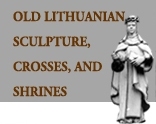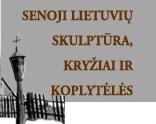- The Lithuanian folk memorial monuments
are one of the
most distinctive art's phenomena in Europe. Regardless
of all disasters which overtook Lithuania the pillar-type
crosses, roofed pillar-type crosses, ordinary crosses and
miniature chapels used to be erected in farmsteads, by
the way side, at crossroads, on river banks, in cemeteries,
churchyards, streets and squars of towns and villages and other
places.
- For many centuries the memorial
monuments in Lithuania were created from the wood. To satisfy the
simple people's insatiable desire for beauty the folk masters used
to decorate monuments not only with sculptures, but also with
painting and graphic works. In these monuments all kinds of visual
art were fitted with smallscalled architecture. It was a standart
till the 19th c. that only woden monuments were sacred, for thomb
monuments even trees were specially chosen - for menoak, ash, for
women-lime, fir. The research shows that being of dolatry tradition.
Only later on in the fall of the 18th and beginning of the 19th
centuries spreading Romanticism and technical progress were used
iron and stone. As the Lithuanian folk wooden memorial monuments and
their decoration are researched more deeper, in the book we discuss
the problemmes of sources and development. The author researched the
folk memorial monuments made of stone for a long time with an aim to
fill a gap in Lithuanian folk art's history. A larger part of this
research was published in my book "Lithuanian folk art memorial
monuments made of stone" in 1993. The main part of this book is
devoted to memorial monuments made of stone and folk
artists-creators. The folk masters stone-cutters appropriated types,
form and
- decoration from the monuments
made of wood prolonging their tradition of creation. There were
several kinds of constructions typical to wooden monuments: a stem
with a roof, a stem with one or several cross - pieces conical
broach roof and crosses with relief decoration, also cemetery gate.
The spread of granite monuments in the Lithuanian ethnographic
territory - analogical to the woden creations of such a type. In
the fall of the 18th c. a fairly short-lived material wood was
changed to iron little suns or ornamented little crosses which were
forged by folk masters creators. In the 19th c. the smiths created
also variants of iron thomb crosses, wich very quickly have spread
in all territory of Lithuania. But the iron art is researched very
little. The author one part of this book devoted to the research of
iron crosses' heads and originality of iron thombs' crosses. The aim
of author is to show the concise history on the Lithuanian folk
memorial monuments. The first attempt to present a reader the
Lithuanian folk memorial
monuments research's material as the whole.
- The book is meant for students,
artists, art critics and the public at a large interested in the
heritage of Lithuanian folk culture and its development.

